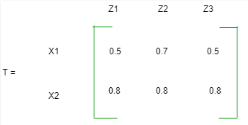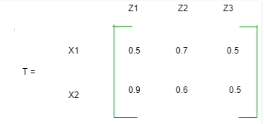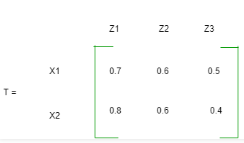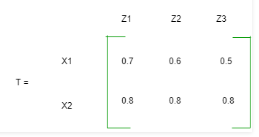PREVIOUS YEAR SOLVED PAPERS - July 2016 Paper 3
- Option : B
- Explanation : The region of feasible solution of a linear programming problem has a convexity property in geometry, provided the feasible solution of the problem exists. Convexity is a measure of the curvature in the relationship between prices and yields. Other term doesn't related to linear programming problem. So, option (B) is correct.
- Option : D
- Explanation :
- Revised simplex method requires lesser computations than the simplex method.Correct
- Revised simplex method automatically generates the inverse of the current basis matrix.Correct
- Less number of entries are needed in each table of revised simplex method than usual simplex method.Correct All statement are correct.
So, option (D) is correct.
- Option : D
- Explanation : Since x is related to y and y is related to z, to relate universe x and universe z we have to compute max-min composition: x1z1= max(min(0.7, 0.9), min(0.5, 0.1)) = max(0.7 0.1) = 0.7 x1z2= max(min(0.7, 0.6), min(0.5, 0.7)) = max(0.6, 0.5) = 0.6 x1z3= max(min(0.7, 0.2), min(0.5, 0.5)) = max(0.2, 0.5) = 0.5 x2z1= max(min(0.8, 0.9), min(0.4, 0.1)) = max(0.8, 0.1) = 0.8 x2z2= max(min(0.8, 0.6), min(0.4, 0.7)) = max(0.6, 0.4) = 0.6 x3z3= max(min(0.8, 0.2), min(0.4, 0.5)) = max(0.2, 0.4) = 0.4 So, option (C) is correct.
- Option : D
- Explanation : According to question: A={(0.3, 1), (0.6, 2), (1, 3), (0.7, 4), (0.2, 5)} B={(0.5,11), (1, 12), (0.5, 13)} first add the numbers(x + y = z) and write the min membership value since function is min((μA(x),μB(x)) u will get following 15 terms: {(0.3, 12), (0.3, 13), (0.3, 14), (0.5, 13), (0.6, 14), (0.5, 15), (0.5, 14), (1, 15), (0.5, 16), (0.5, 15), (0.7, 16), (0.5, 17), (0.2, 16), (0.2, 17), (0.2, 18) f(A + B) is equal to {(0.3, 12), (0.5, 13), (0.6, 14), (1, 15), (0.7, 16), (0.5, 17), (0.2, 18)} So, option (D) is correct.


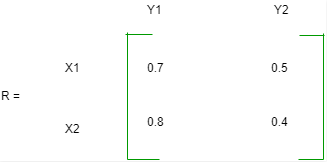 and
and
